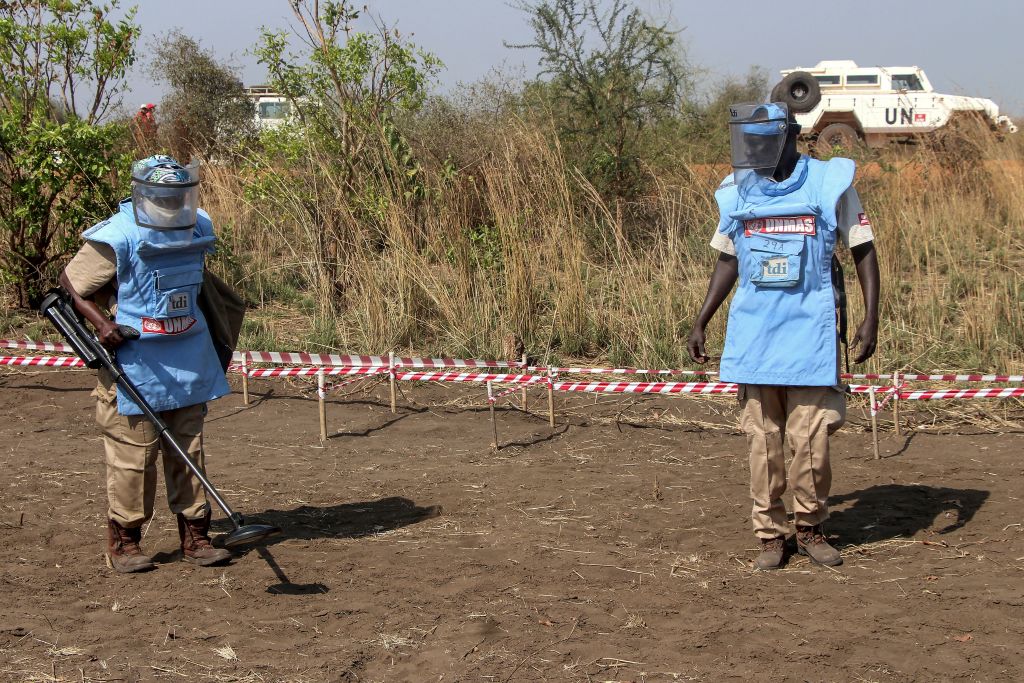ADF STAFF
Wearing heavy work boots and a hard hat, Nancy Sunday climbed into her MineWolf, an armored vehicle that tills land to crush or detonate buried mines and other explosives.
The mines, some of which date back to the 1980’s, are deadly remnants of the country’s fight for independence and other battles. Over the years, multiple combatants have laid thousands of mines across roads and fields around the country.
Sunday’s hazardous work for Norwegian People’s Aid (NPA) is important as more than 5,000 people have been killed or injured by mines and unexploded ordnance in South Sudan since 2004, according to the United Nations Mine Action Service (UNMAS), which supports NPA. More than 1 million land mines have been destroyed during that time.
“It’s important to take out the mines because when there are mines here, people can’t work, can’t cultivate,” Sunday said in a U.N. report. “When they cultivate, sometimes the mines will detonate and kill the locals.”
Peter Chol Maduk has worked as a deminer in South Sudan since 2009. In that time, he said he has helped find and detonate more than 500 mines, bombs and grenades.

“When I walk in the mine field, I am fighting an enemy,” Maduk told Danish Church Aid Alliance, a nongovernmental organization (NGO) that works on development issues, disaster relief and advocacy efforts. “One mistake can be fatal, so I need to carefully consider every step I take. Anything in the ground can be a mine, so we examine everything we find and scan the entire surface with our metal detectors. It feels as if the soil is our friend and we communicate through the metal detector.”
UNMAS Extension Granted
Children commonly mistake unexploded ordnances for toys. In March, seven women and three boys were killed after a boy mistakenly played with a grenade while searching for mangos in a village in Western Bahr el Ghazal state.
To prevent such instances, workers with Mines Advisory Group, a United Kingdom NGO, engage with communities to raise awareness about the danger of mines and other unexploded ordnances. They give talks that feature large posters showing illustrations of various explosives and distribute pamphlets to children; UNMAS does similar work.
South Sudan granted UNMAS an extension, until 2026, to rid the country of all unexploded ordnance. UNMAS has cleared more than 84 square kilometers of cluster munitions and mines in nearly two decades.
It has also destroyed more than 6.3 million items of small arms ammunition and 1.2 million items of explosive devices, including more than 81,000 cluster munitions, and 1.1 million other items of unexploded ordnance, according to the UNMAS website. It has also cleared more than 4,800 kilometers of road, enabling the U.N. and humanitarian partners to deliver aid.
Still, some experts say it will be difficult to reach the 2026 goal as munitions are found across the country daily.
“The contamination is too huge,” Jurkuch Barach Jurkuch, chairperson for the South Sudan National Mine Action Authority, told Al Jazeera. Jurkuch added that efforts are hampered by a lack of funding, ongoing insecurity and flooding.
‘My Area is Dangerous’
Eastern Equatoria state, along the Ugandan border, has South Sudan’s most areas with cluster munitions in the country — 55 out of a total of 123 — according to Mine Action Review. It is also South Sudan’s second-most-returned-to state since the peace agreement was reached in 2018.
Jacob Wani recently returned to his home there after fleeing the war eight years ago. The 45-year-old farmer’s excitement for a new start was dashed when authorities told him his land in Magwi County was banned and full of mines.
“My area is dangerous,” Wani told Al Jazeera. “I do not have the capacity to rebuild in this place and I am also afraid (of explosives). If I go, maybe something can hurt me.”

